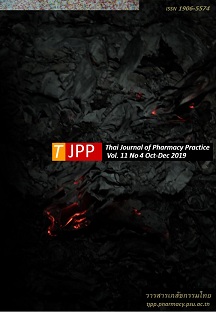ผลของการดูแลที่บ้านโดยทีมสหสาขาวิชาชีพต่อคุณภาพชีวิตของผู้สูงอายุที่ติดบ้านและติดเตียง
Main Article Content
บทคัดย่อ
วัตถุประสงค์: เพื่อศึกษาผลของการดูแลผู้สูงอายุที่ติดบ้านและติดเตียงที่บ้านโดยทีมสหสาขาวิชาชีพต่อปัญหาสุขภาพและคุณภาพชีวิตของผู้ป่วย วิธีการ: แบบของการวิจัย คือ การศึกษาแบบกึ่งทดลองที่ประเมินผลก่อนและหลัง การดูแลผู้สูงอายุที่บ้านที่ติดบ้าน 18 รายและติดเตียง 9 รายโดยการเยี่ยมบ้านของทีมสหสาขาวิชาชีพจำนวน 3 ครั้งใน 6เดือน การดูแลผู้ป่วยเริ่มด้วยการค้นหาปัญหาสุขภาพของผู้ป่วย ประเมินปัญหาเบื้องต้นทั้งด้านกายภาพและการใช้ยา และแก้ไขปัญหาร่วมกันระหว่างทีมและครอบครัวของผู้ป่วย ผลลัพธ์ที่ประเมิน คือ คุณภาพชีวิต ปัญหาจากยา (drug related problems: DRPs) ความร่วมมือในการใช้ยา ผลลัพธ์ทางคลินิกของโรคความดันโลหิตสูง โรคเบาหวาน และโรคไต ภาวะซึมเศร้า การเคลื่อนไหว ภาวะแทรกซ้อนจากการติดเตียง และความพึงพอใจของผู้รับบริการ การเก็บข้อมูลใช้แบบประเมินอาการไม่พึงประสงค์จากการใช้ยาที่อิงเกณฑ์ขององค์การอนามัยโลก แบบสัมภาษณ์ความร่วมมือในการใช้ยา (Brief Medication Questionnaires; BMQ) และการนับเม็ดยา แบบคัดกรองโรคซึมเศร้า (9Q) แบบประเมินการเคลื่อนไหว (Modified Barthel Index) แบบประเมินความเสี่ยงการเกิดแผลกดทับ (Braden’s score) แบบวัดคุณภาพชีวิต EQ-5D-5L-VAS และแบบสอบถามความพึงพอใจของผู้รับบริการ ผลการวิจัย: ก่อนการวิจัยในกลุ่มติดบ้านพบ DRP ในผู้ป่วย 8 คนจากทั้งหมด 18 คนตอน และในกลุ่มติดเตียงพบ DRP ในผู้ป่วย 6 คนจากทั้งหมด 9 คน การแทรกแซงสามารถขจัด DRP หมดไปได้ในผู้ป่วยทุกคน จำนวนผู้ที่ร่วมมือในการใช้ยาเพิ่มขึ้นในกลุ่มติดบ้านจาก 6 คน เป็น 17 คน (P<0.001) และในกลุ่มติดเตียงเพิ่มจาก 4 คน เป็น 9 คน (P=0.031) การแทรกแซงทำให้ผลลัพธ์ทางคลินิกเข้าเกณฑ์มาตรฐานเพิ่มขึ้น โดยในกลุ่มติดบ้านเพิ่มจาก 5 คน เป็น 18 คน (P<0.001) และในกลุ่มติดเตียงเพิ่มจาก 8 คน เป็น 9 คน (P=0.347) ตัวอย่างมีภาวะซึมเศร้าลดลง โดยในกลุ่มติดบ้านลดลงจาก 10 คน เป็น 3 คน (P<0.001) และในกลุ่มติดเตียงลดลงจาก 9 คน เป็น 6 คน (P=0.091) ผู้ป่วยกลุ่มติดเตียงมีภาวะแทรกซ้อนจากการติดเตียงลดลงจาก 9 คนเป็น 4 คน (P=0.059) หลังจากการแทรกแซง คุณภาพชีวิตของตัวอย่างเพิ่มขึ้น 0.08 (P<0.001) ในกลุ่มติดบ้าน และ 0.05 (P<0.001) ความพึงพอใจต่อการดูแลของทีมสหสาขาวิชาชีพเพิ่มขึ้น 0.63 คะแนน (P<0.001) ในกลุ่มติดบ้าน และ 0.50 (P<0.001) ในกลุ่มติดเตียง Bathel index เพิ่มขึ้น 3.05 (P<0.001) ในกลุ่มติดบ้าน และ 1.67 (P<0.001) ในกลุ่มติดเตียง ส่วนภาวะซึมเศร้ามีค่าลดลง 1.66 (P<0.001) ในกลุ่มติดบ้าน และ 3.44 (P<0.001) ในกลุ่มติดเตียง สรุป: การดูแลสุขภาพผู้ป่วยที่ติดบ้านและติดเตียงที่บ้านโดยทีมสหสาขาวิชาชีพ ทำให้ DRPs และภาวะซึมเศร้าลดลง ภาวะแทรกซ้อนจากการติดเตียงมีแนวโน้มลดลงในกลุ่มติดเตียง ผู้ป่วยมีความร่วมมือในการใช้ยา มีผลลัพธ์ทางคลินิกเข้าเกณฑ์มาตรฐาน การเคลื่อนไหว คุณภาพชีวิต และความพึงพอใจต่อการดูแลมากขึ้น ดังนั้น จึงควรส่งเสริมให้การเยี่ยมบ้านดังกล่าวเป็นนโยบายและควรเพิ่มเครือข่ายความร่วมมือกับองค์กรปกครองส่วนท้องถิ่นเพื่อเพิ่มคุณภาพชีวิตของผู้ป่วยในด้านอื่น ๆ ต่อไป
Article Details
ผลการวิจัยและความคิดเห็นที่ปรากฏในบทความถือเป็นความคิดเห็นและอยู่ในความรับผิดชอบของผู้นิพนธ์ มิใช่ความเห็นหรือความรับผิดชอบของกองบรรณาธิการ หรือคณะเภสัชศาสตร์ มหาวิทยาลัยสงขลานครินทร์ ทั้งนี้ไม่รวมความผิดพลาดอันเกิดจากการพิมพ์ บทความที่ได้รับการเผยแพร่โดยวารสารเภสัชกรรมไทยถือเป็นสิทธิ์ของวารสารฯ
เอกสารอ้างอิง
2. Thaweesit S, Sunpuwan M, Chuanwan S. Population structure and economic stability of ASEAN [online]. 2013 [cited Mar 10, 2015]. Available form: www.ipsr .mahidol.ac.th/ipsr/AnnualConference/Download/2556/2556_conference_full.pdf
3. Damrikanlert L. Research aimed at health enhancing value of people's health care [online]. 2015 [cited Mar 10, 2015]. Available form: www.hsri.or.th/sites/ default/files/.../02_พญ.ลัดดา_ดำริการเลิศ.pdf.
4. National Health Assembly. Long term care in Thailand [online]. 2012 [cited Mar 10, 2015]. Available form: www.samatcha.org/?q=taxonomy/term/22/all
5. Department of Medical Services. Barthel activities of daily living: ADL. 2015 [cited Mar 10, 2015]. Available form: happynetwork.org/upload/forum/pic5 552fe2898d4a.doc.
6. Glendinning C, Jones K, Baxter K, Rabiee P, Curtis L, Wilde A, et.al. Home Care Re-ablement services: Investigating the longer-term impacts [online]. 2010 [cited Mar 10, 2015]. Available form: www.york.ac.uk /inst/spru/research/pdf/Reablement.pdf
7. Maneerat M, Waleekhachonloet O, Phumart P, Sangasri P. Effect of home health care by pharmacy students on knowledge, compliance, and wasted drug problems in households. Thai Journal of Phar macy Practice. 2010; 2: 24-34.
8. Department of Mental Health. Ministry of Public Health. Clinical Practice Guideline of Psychosocial Intervention for Depressive Disorder for Psychiatric nurse in Tertiary care [online]. 2010 [cited Mar 10, 2015]. Available form: www.thaidepression.com/ww w/58/cnpgtertiarycare.pdf
9. Ministry of Public Health. Palliative care guideline 2014. [online]. 2014 [cited Mar 10, 2015]. Available form: www.dms.moph.go.th/dmsweb/cpgcorner/แนวทางการดุแลผู้ป่วยระยะสุดท้าย.pdf
10. Dajpratham P, Meenaphant R, Junthon P, Pianmana kij S, Jantharakasamjit S, Yuwan A. The Inter-rater reliability of Barthel Index (Thai version) in stroke patients. Journal of Thai Rehabilitation 2006; 16: 1-9.
11. Pattanaphesaj J, Thavorncharoensap M. The EQ-5D-5L Thai version [online]. 2015 [cited Mar 10, 2015]. Available form: www.hitap.net/wp-ontent/uploads/20 15/08/PB_EQ5D5L-final-for-web.pdf
12. The Seventh Report of the Joint National Committee on Prevention, Detection, Evaluation, and Treatment
of High Blood Pressure [online]. 2003 [cited Mar 10, 2015]. Available form: www.nhlbi.nih.gov/files/docs/ guidelines/express.pdf
13. American Diabetes Association. Standards of medical care in diabetes-2015. Diabetes Care 2015; 38 (sup 1): S1-86.
14. International Society of Nephrology. Clinical practice guideline update for the diagnosis, evaluation, prevention, and treatment of chronic kidney disease–mineral and bone disorder (CKD-MBD) [online]. 2017 [cited Aug 15, 2017]. Available form: kdigo.org /wp-content/uploads/2017/02/2017-KDIGO-CKD-MB D-GL-Update.pdf
15. Kamlungdee U, Bunmusik P, Watcharawiwat A. The development of home visit guidelines for patients with type 2 diabetes mellitus or hypertension run by family care team. Southern College Network Journal of Nursing and Public Health. 2017; 4: 34-45.
16. Atthawong P, Anusornprasert N, Sardlee H. Home nursing care (HNC) for bed-ridden patients from primary care unit (PCU). Journal of Health Science. 2017; 26: 89-93.
17. Makchumnum P, Poolsup N, Pongmesa T. Effect of home health care in hypertensive patients by multidisciplinary team. Veridian E-Journal, Science and Technology Silpakorn University. 2016; 3: 13-33.
18. Phuaksawat P, Nakkhun N, Rotchanarak W. Situa tions, problems, and health care needs for home-bound and bed-bound chronically ill patients in Suratthani municipal community. Nursing Journal of the Ministry of Public Health. 2015; 1: 54-64.
19. Tumviriyakul H. Need for home health care in deep South of Thailand. Thai Journal of Primary Care and Family Medicine. 2011; 2: 15-25.


